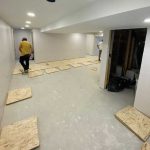

However, DMX also allows for flooring such as vinyl, laminate, or hardwoods to be directly installed on top of it. It is a polyethylene material that utilizes dimples to provide air gaps. DMXĭMX is similar to the above-mentioned Platon subflooring tool, though it varies slightly.

Plywood comes in different sizes and thicknesses, meaning there is an option best suited for your home. It’s often hailed as the most popular subfloor option, especially so by builders who prefer the adaptable and cheap material to alternatives like DRIcore. Plywood is a popular choice for subflooring and has been used for decades to provide a barrier for buildings. Upon laying this product on the floor, preferably concrete, the unique design and dimples allow for continual air flow and help prevent a buildup of moisture that can lead to serious issues down the line. This subflooring option is a patented sheet of high-density polyethylene, a type of plastic, with a dimpled surface. These floating subfloors are made from Oriented Strand Board (OSB) but adapted to work with the cement with tongue-and-groove technology.

You will simply need to lay down a floating subfloor that can work with your stubborn concrete. Typically when you think of subflooring you think of something adaptable and malleable, yet your cement flooring can be used. Instead, you might find luck with alternatives that offer similar benefits with substantially lower costs. If you’re not able to shell out that money upfront, especially if you’re completely renovating a space and money is tight, then DRIcore may not be a valid choice. Why DRIcore May Not be the Best ChoiceĭRIcore can be an expensive choice for subflooring or sub walls. Without subflooring, your base layer, for example, the cement floor, is completely vulnerable to the elements and will trap moisture in between the layer itself and the floor you’ve laid down over top. If you’re redoing the floors in your basement, garage, bathroom, or any area otherwise prone to dampness, you should be installing a subfloor. If a subfloor is not present, moisture can get trapped and lead to serious problems down the line. Before you place those hardwood planks over your cement garage floor, you will want to add the subfloor, which acts as a buffer to help air out the space between the base floor and that top layer. So, for example, if you wanted to turn your garage into a family room and wanted to add hardwoods to complete the look. You will only ever need a subfloor barrier if you plan to lay flooring over top of that base layer. Subflooring comes in multiple forms that range in cost and effectiveness. Subflooring is used to cover and protect the ground floor from the elements.

The airspace this raised structure creates is hard to beat, especially when paired with easy installation. When installing, DRIcore interlocks to form a durable sheet built to protect your floors, rather than having to tirelessly drill or fasten the different parts together. The mechanics of DRIcore are very intricate, but the subflooring option is essentially a polyethylene barrier that helps keep moisture from the subfloor via the high-density material and its core. How Does DRIcore Work?ĭRIcore was created by a contractor who was looking to minimize the hassle of traditional subflooring processes. In this guide, we’ve broken down all of the alternatives and which is best for your needs. While DRIcore can be a great option, it is not the only one that you have. As such, it is especially useful in areas like basements and garages or any other prone to these issues. DRIcore particularly protects against issues associated with moisture such as mold and mildew that can worsen over time and threaten the structure of your home. DRIcore is a subfloor or subwall technology that fights against potentially devastating side effects of general wear and tear.


 0 kommentar(er)
0 kommentar(er)
